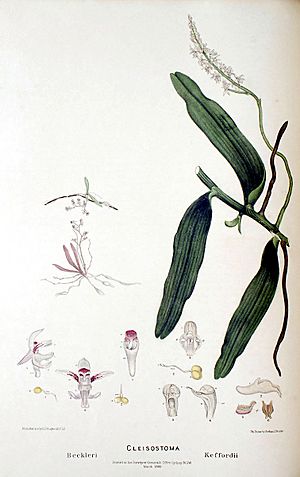Imp orchid facts for kids
Quick facts for kids Imp orchid |
|
|---|---|
 |
|
| Illustration from Robert D. FitzGerald#Australian Orchids | |
| Scientific classification | |
| Genus: |
Papillilabium
|
| Species: |
beckleri
|
| Synonyms | |
The imp orchid (scientific name: Papillilabium beckleri) is a special type of orchid. It is the only plant in its group, called the genus Papillilabium. This small orchid is an epiphyte, which means it grows on other plants like shrubs and trees, but it doesn't harm them.
Imp orchids have many thin roots. They also have a few long, thin leaves. Their flowers are usually pale green or brownish. These flowers smell nice and make a sweet liquid called nectar. They also have a unique, bumpy lip, which is called a labellum.
You can find the imp orchid growing in humid places. It often lives near streams in south-east Queensland and the Sydney area of New South Wales.
Contents
What Does the Imp Orchid Look Like?
The imp orchid is a type of herb that grows on other plants. It has many thin, wire-like roots. Each plant has one main stem, which is about 10–40 millimetres (0.39–1.6 in) long.
Each stem usually has two to six leaves. These leaves are long and narrow, like a spear. They are about 30–50 millimetres (1.2–2.0 in) long and 2–4.5 millimetres (0.079–0.18 in) wide. Sometimes, the leaves have pink or purple spots.
The orchid can have up to eight flowers. These flowers are pale green or brownish. They are about 7–8 millimetres (0.28–0.31 in) long and 4–6 millimetres (0.16–0.24 in) wide. Some flowers might have purple marks. The flowers grow on special stems that are 15–40 millimetres (0.59–1.6 in) long.
The flower's sepals and petals spread out wide. The sepals are about 3 millimetres (0.12 in) long. The petals are a little narrower. The labellum, or lip, of the flower can be white, green, or yellowish. It is about 4 millimetres (0.16 in) long and 3 millimetres (0.12 in) wide. The labellum has three parts, called lobes. The two side lobes are long and thin. The middle lobe is bumpy and has a small spur, which is like a tiny pouch, about 2 millimetres (0.079 in) long. Imp orchids usually bloom from September to October.
How Did the Imp Orchid Get Its Name?
The imp orchid was first officially described in 1873. A scientist named George Bentham wrote about it. He used notes from another scientist, Ferdinand von Mueller. Bentham named it Cleisostoma beckleri. He published this description in a book called Flora Australiensis. The plant he described was found by Hermann Beckler near the Clarence River.
Later, in 1967, a scientist named Alick Dockrill changed its name. He renamed it Papillilabium beckleri. The name Papillilabium comes from two Latin words. Papilla means "nipple" or "bud". Labium means "lip". The second part of the name, beckleri, honors Hermann Beckler. He was the person who collected the first plant specimen used to describe the species.
Where Does the Imp Orchid Live?
The imp orchid, Papillilabium beckleri, likes to grow on shrubs and trees. It prefers places that are humid and wet. You can often find it near streams.
This orchid lives in a specific area of Australia. It is found from Mapleton in Queensland down to the Royal National Park in New South Wales.
See also
 In Spanish: Papillilabium para niños
In Spanish: Papillilabium para niños

